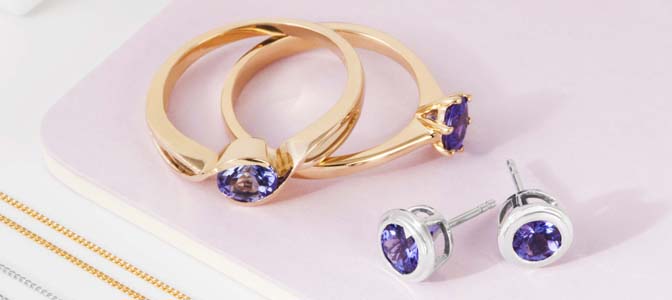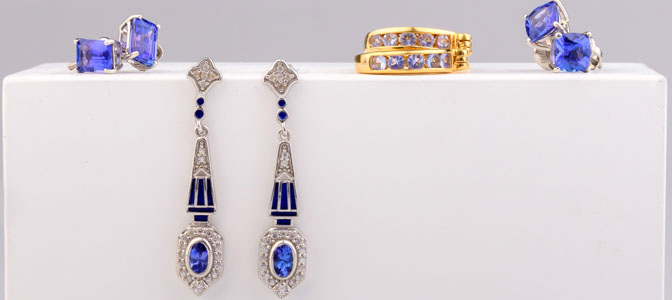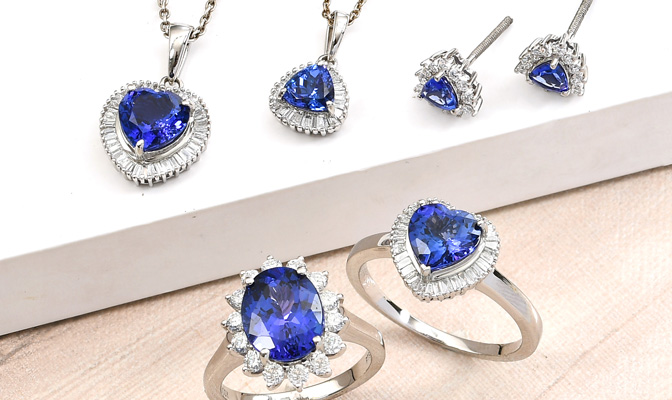
Introduction
Spell-binding with its colours and mysterious with its clarity, tanzanite has been the stone everyone has fallen in love with! Boasting characteristics that are unique to it and it alone, you can rarely find a gem as beautiful as this. Jewellery designers cannot stop raving about its beauty and connoisseurs cannot stop collecting more of it. However, there is so much to know and learn about the mystery that this rare stone is. We’ve collected detailed data about this rare treat and put it all here.

Origin & Supply
The name of this stone has been originated from where it was exclusively found. Tanzanite is a single stone that is known to be sourced from only one location over the globe, and that was Tanzania, Africa. It is also the only stone that altered Birthstone chart built in 1912. It was added to as the birthstone of December, late in 2002. This name was suggested by the extremely famed and popularly loved Tiffany & Co., seeing as its commercial name “blue-violet zoisite” didn’t hold much customer appeal.
Discovered late in 1967, tanzanite was a gem that was instantly loved and coveted by everyone. It was initially thought to be peridot or even aquamarine, before geologists realised that it is unique in its make and colour. The sparkling perfect gem instantly became the talk of reigning jewellery fashion. By 1971, about two million carats of tanzanite were exported from the country, before the mines got nationalised by the Government of Tanzania and they put a ban on export of this stone.
For the encouragement and spur of local processing units, therefore affecting the economy, a ban was placed on export of rough stones over a gram, in the year 2010. The government believed that if the stone was processed in the country, it will have a better effect on growth of their own economy. This made the value of this gem grow overnight.
How is Tanzanite Mined?
The mining area of tanzanite was divided into 4 main sections, back in 2010. These were called Blocks A, B, C, and D. The blocks A and B have been kept apart for only foreign trade and investment. Geographically significantly bigger, Blocks C and D are for local operators, where national miners procure tanzanite in rough form.
It is believed by geologists that the sparkling gem is located about 200 metres below the surface of Earth. This is why tunnels and shafts are dug up to procure the gem. Deeper mines need extra-secure infrastructure with provisions of air and water. The boulders found are taken for processing, where excessive dirt is removed, and the crystal is chiselled for jewellery.

Facts About Tanzanite
There are so many interesting things that you need to know about this gorgeous stone. Below, we have mentioned a few fun facts about it that will make it seem so much more precious. Read on:
- Tanzanite gets it name from its place of origin. It is only mined in Tanzania, Africa and cannot be found anywhere else. Only a few stones have been named after the place of their origin.
- The name was offered by the extremely popular Tiffany & Co. They suggested the name because its commercial name “blue zoisite” didn’t sound much appealing, especially given its resemblance to “blue suicide.” They thought calling it tanzanite would make it more memorable.
- Tanzanite birthstone had been added to the list in the late 2002. It was the first addition made to the list, which was curated in 1912! It has been called the birthstone of the month of December.
- It's powerful and intense colour has often been associated with confidence. People believe that it is the perfect symbol of prosperity, new life, and new beginnings.
- The sparkling perfect gem can be found in only one place in the whole world. As of current, it has been mined from Mererani Hills of Northern Tanzania, which is near the city of Arusha and Mount Kilimanjaro.
- Apart from its stunning clarity and colour intensity, it is also known for its pleochroic nature. This means that it can display as many as three different colours when it is viewed from different angles.
- The largest tanzanite ever found weighs at whopping 16,839 carats! It has been called The Mawenzi, which is after the second highest peak after Mount Kilimanjaro.
- The locals believe that the gem was formed from lightening. Gods made the mountains alight with fire and when the fire brunt down, rocks had tanzanite in them. Due to the low availability and high demand of tanzanite, it is had been counted among the heirloom jewels. It is also the best gift you can present for the 24th wedding anniversary.
- This sparkling and intensely-hued gemstone has been famously called “The Gem of 20th Century” by collectors and appreciators of its beauty.

Properties of Tanzanite
Even though it was introduced relatively late in the gemstone word (during the year 1967,) tanzanite has built its reputation as the second most popular coloured gemstone, second to sapphire. The hypnotising depths of this spectacular treat blend well with the crystal-clear make and perfect faceting. The prized and treasured tanzanite is limitedly available yet has a massive appeal worldwide. Like most of the crystals, this too, has determining factors that can help you grade the specimen better. Below are mentioned the 4Cs of this sparkling gem.
- 1. Colour: Unique and exclusive to this gemstone, tanzanite flaunts a rich blue-violet shade. In fact, facts mention that it has a rare pleochroic tendency, which lets it display three different colours when viewed from different angles. Prices of tanzanite tend to go up as the colour gets richer and more intense. This is why you’ll see that more saturated-colour stones are usually much higher-priced than the washed-out and paler findings. The richest colour of the stone is when it has intense violet-blue colour, which displaya different shades and tones when viewed from different angles. In their rough findings, these stones are usually brown.
- 2. Cut: Cut plays an extremely important role of determining the quality and grade of your sparkling specimen. Due to its rare and extremely treasured pleochroic tendencies, your tanzanite needs to be in the perfect cut to flaunt all colours in it. Perfectly-done faceting is of pivotal importance as cutters believe that with more cuts, the stone tends to lose profits, too. In conclusion, the cuts need to be so that it flaunts the rich and intense blue-violet colours of the stone with perfect pleochroism and still maintains an even shape. Popular and more seen cuts of the stone are oval and cushion. However, there are several cuts available like trillion, round, princess, and more.
- 3. Clarity: The clarity factor of this gem is quite like that of diamonds. Any visible inclusions found in its make tend to reduce the price of your tanzanite. That said, some finer specimens may display small black dots, but they’re noticed under magnification and do not, in any way, affect the transparency of this sparkling perfect jewel. The high-priced gems are known to have a brilliantly clear grade, where one can see through perfectly.
- 4. Carat: Tanzanite’s price is easily affected with its carat. It’s a gem that’s rarely found in bigger sizes, especially the ones with a perfectly intense colour and breath-taking clarity. If you’re looking for a posh and prized feature, it will be above 5 carats of weight with passionate blue-violet colour and stark clarity. The low-priced stones are found in lighter carat weight and have a paler and washed-out colour in them.
Tanzanite Gemstone Treatment Most of the gemstones in today’s market have undergone some kind of treatment to enhance their appearance and make their built more stable and durable. Tanzanite, too, undergoes heat treatment process, which makes it colour richer and darker. It helps in enhancing its dichroic or pleochroic characteristic, too. This a universally accepted treatment. That said, the stone is naturally found and the synthetically-created ones are considered imitations.
It needs to be said that this heat treatment does not affect the price or value of this gem. It is accepted by several jewellers. But you still should ask your dealer about the treatment that your stone has went through.

What to Remember While Buying Tanzanite?
If you’re stepping out to buy this lovely and rich gemstone, there are a few things that you need to pay focus to. Some tips and tricks may always help you in getting the best value of your buck.
- Like for most of the other gemstones, it is important for you to educate yourself before you buy this gem. Know in depth about the sparkling perfect treat and study its types before you decide which piece suits your budget.
- Another valuable tip is to study the 4Cs of your specimen. If you’ve chosen a particular piece, deeply study its cut, colour, carat, and clarity. These 4 determinants will tell you a lot about its value. You may find detailed description of 4Cs above.
- Tanzanite only ranks 6.5-7 on the Mohs Scale of Hardness. This means that this gem is brittle and not as strong as sapphire or diamond. It may also have some cracks or fractures.
- Because of the low rank and low hardness of this stone, you need to make sure that it is securely placed in your jewellery design. It might be favourable if it is set in a bezel as it secures the faceting and corners of stone. It might not be the best choice for daily-wear jewellery.
- Know that the tanzanite piece that displays pleochroism (ability of stone to feature three different colours from different angles,) it will always be pricier. It’s one of the most redeemed traits of this gorgeous gem and prices fluctuate on its basis.
- Be sure to closely inspect tanzanite before you invest in it. Keep an eye out for cracks, fractures, nicks, and more. Tanzanite is a soft stone and these small cracks might break the stone over time and regular use.
- The Type I tanzanite specimen is always going to be pricier, owing to the fact that it will have no visible inclusions. Type III, on the other hand, will feature some small occurrences. These imperfections reduce the quality as well as value of the stone.
- Here’s a handy tip. If you’re investing in a jewellery piece that has both diamonds as well as tanzanite, then it you can have lower-priced diamonds. Tanzanite, alone, is a pricy centre jewel with strong and bold hues. Lighter-coloured diamonds will only give it an excellent contrast. These diamonds don’t need to be extremely expensive.
- Always ask for certification. The gem usually tips on the more expensive scale of the balance. It is important that you have verification of its authenticity. Always ask your dealer for a certificate of originality. Or purchase the gem from a reliable name.
- Almost all the gemstones in the circulating market have undergone some sort of treatment. It is important for you to enquire your dealer about the treatments that your tanzanite has undertaken. Heat treatment is an acceptable one.
FAQ's
Is Tanzanite Worth More Than A Diamond?
Tanzanite has been counted among the rarest gemstones found on the Earth. It is mined from a single source in the whole world. However, it still commands a lesser price than the untreated and natural diamonds.
Is Tanzanite A Rare Gem?
Yes, Tanzanite has been considered to be among the rarest stones on this planet. It has also been called the “heirloom stone” because of its high value and depleting availability. Investing in this rare stunner is a good idea.
Which Is the Best Colour of Tanzanite?
Best grade and specimen of tanzanite will feature an intense and rich shade of blue-violet. The stone will also display pleochroism, which means that it will display three different colours when it is viewed from different angles.
Does Tanzanite Scratch Easily?
Due to its low rank of 6.5-7 on the Mohs Scale of Hardness, tanzanite is considered to be a soft and brittle stone. It is noted that it is susceptible to easy breaking and/or shattering when handled carelessly.
Can Tanzanite be lab-created?
Over the years, all attempts of creating synthetic varieties of tanzanite have failed. It is a gemstone that’s unique and exclusive to the nature. However, a close-resembling stone called Forsterite has been created with hues that come close to the cheaper versions of tanzanite. However, a gemmologist can very easily place difference in both as Forsterite has green undertones.
Is Tanzanite Still Being Mined?
Yes, tanzanite is still actively being mined in Tanzania, the only place in the world where it found. However, the government has placed bans of export of rough stone that weighs over a gram. This caused a great decline in its availability.
How Do You Clean Tanzanite Jewellery?
If you’re looking to clean the jewellery at home, the best way is to soak it in lukewarm soapy water for about 20 minutes. Then use a soft washcloth to gently wipe away the dirt and grime. Rinse your jewellery under running water and wipe it dry using a light hand.
Is Tanzanite Heat Treated?
Like most of the stones found in the current market, tanzanite too, is heat treated. This is done to make its colour richer and more intense. It also stabilizes the stone and makes it a little more durable.
Is Tanzanite A Birthstone?
Yes, Tanzanite Birthstone was declared for the month of December. It was added to the list during 2002 and was the first addition to the list made in 1912.
Can You Wear Tanzanite Every Day?
Unfortunately, Tanzanite does not score good on the Mohs Scale of Hardness. It only ranks from 6.5-7, which means that it is a considerably softer stone. It is susceptible to easy breaking, and thus, shouldn’t be worn every day. If worn, it is preferable to use in secure setting such as bezel to protect it from external damage on impacts.








































